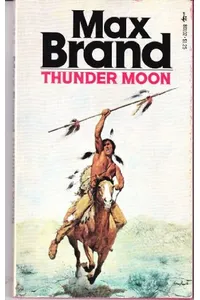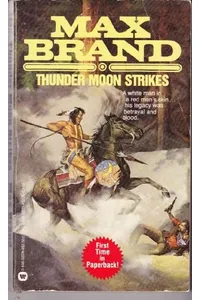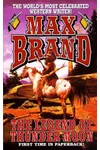Saddle up and step into the thrilling world of Thunder Moon, where a Cheyenne warrior’s epic journey through the American Old West will leave you breathless! Max Brand’s Thunder Moon series, a gem of Western pulp fiction, follows the titular hero—a man of mixed heritage grappling with identity, loyalty, and survival in a rapidly changing frontier. With gripping action and heartfelt themes, this series is a must-read for fans of adventure and cultural drama.
Written under the pseudonym Max Brand by the prolific Frederick Schiller Faust, the series blends vivid storytelling with the raw grit of the Old West. Thunder Moon’s saga, published posthumously, captures the clash of cultures and the personal battles of a warrior caught between two worlds, making it a standout in Western literature.
How Thunder Moon Began
Frederick Faust, better known as Max Brand, was a storytelling powerhouse, penning over 500 works, including Westerns, before his death in 1944. The Thunder Moon series, originally serialized in Western Story Magazine in 1927–28, emerged during the height of pulp fiction’s popularity. Faust’s fascination with mythology and the American frontier shaped Thunder Moon, a character inspired by the cultural tensions of the Old West. The series’ novel form didn’t appear until 1970, with the final book published in 2000, cementing its posthumous legacy.
Faust crafted Thunder Moon as a Cheyenne warrior raised by the tribe after being kidnapped as a white infant. This unique premise allowed Brand to explore identity and belonging, setting the series apart from typical Westerns of the era. His sympathetic portrayal of Native American life was daring for its time, offering readers a nuanced perspective on the frontier.
The Heart of Thunder Moon
The Thunder Moon series comprises five novels, each weaving action, drama, and introspection. The first, The Legend of Thunder Moon (1996), introduces Thunder Moon, a white boy raised as a Cheyenne warrior by Chief Big Hard Face. To overcome the stigma of his light skin, he leads a daring raid against the Comanches, proving his courage. Red Wind and Thunder Moon (1996) follows Thunder Moon’s tense negotiations with rival Cheyenne bands, complicated by a mysterious gift that sparks intrigue.
In Thunder Moon and the Sky People (2000), Thunder Moon searches for his white origins, accompanied by his loyal friend Standing Antelope. His encounters with white settlers and the enigmatic Red Wind deepen the series’ exploration of cultural conflict. Farewell, Thunder Moon (1996) sees him betrayed, forcing a return to the plains to protect his people from encroaching whites and Pawnee enemies. Themes of identity, loyalty, and the cost of cultural assimilation run deep, set against the vivid backdrop of the Great Plains.
Brand’s style is fast-paced yet reflective, with rich descriptions of the frontier’s beauty and brutality. Thunder Moon’s internal struggle—balancing Cheyenne traditions with his white heritage—resonates with readers, while the series’ action-packed raids and betrayals keep the pages turning. The Old West setting, with its untamed landscapes and clashing cultures, feels alive, making every book a thrilling ride.
Why Thunder Moon Resonates
The Thunder Moon series stands out for its bold exploration of cultural identity, a theme that feels timeless. At a time when Westerns often stereotyped Native Americans, Brand’s nuanced portrayal of the Cheyenne was groundbreaking, earning praise for its empathy and authenticity. Fans on platforms like Goodreads laud the series for bringing the plains to life, with Thunder Moon’s journey from outcast to legend inspiring readers even today.
Though less known than Brand’s Destry Rides Again, the series has a cult following among Western enthusiasts. Its posthumous publication and enduring appeal showcase Faust’s storytelling genius, ensuring Thunder Moon’s place in the genre’s canon. The series’ blend of action, heart, and cultural insight makes it a hidden treasure for new readers to discover.
- Publication Years: 1970–2000 (novels)
- Number of Books: 5
- Setting: American Old West, Great Plains
- Key Themes: Identity, cultural conflict, frontier life
Dust off your boots and grab The Legend of Thunder Moon to dive into this captivating Western world! Thunder Moon’s adventures await, promising a wild ride through the heart of the Old West.




